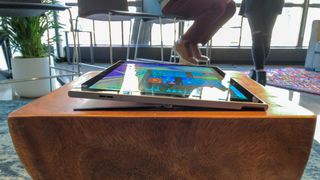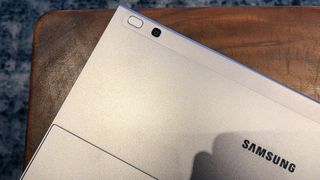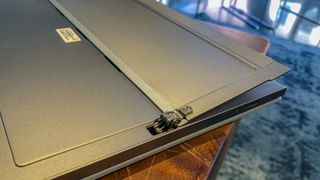Hands on: Samsung Galaxy Book 2 review
Samsung’s next crack at the Windows tablet for productivity has arrived in the Galaxy Book 2, and it’s both completely different while perhaps more of the same.
In fact, it may be the best move Samsung could have made with the device. That, and including both the stylus and keyboard cover accessories in the box.
Naturally, with Snapdragon inside, the Galaxy Book 2’s key feature is LTE connectivity through the modem within the Snapdragon 850 system on a chip, or SoC. What that means for the device’s power profile is yet to be seen, and that is the biggest question mark surrounding the tablet. That said, consider us simultaneously impressed and cautious.

Price and availability
To get a Samsung Galaxy Book 2 replete with an S Pen stylus and keyboard, it will cost you $999 (about £757, AU$1,399) in the US when it launches on November 2nd on AT&T, Microsoft and Samsung’s online stores. The tablet is also going straight to AT&T, Sprint and Verizon retail stores later this month.
This is the only configuration for Galaxy Book 2 at the moment, which nets you a Qualcomm Snapdragon 850 processor backed up by 4GB of memory and 128GB of solid-state storage. This all sits behind a 12-inch Super AMOLED display with a 2,160 x 1,440-pixel resolution.
As for connectivity and imaging, the tablet offers up two USB-C 3.1 ports (for both charging and data transfer), a microSD slot, a headphone jack, one 5-megapixel (MP) webcam up front and an 8MP camera around the back.
Comparatively speaking, Apple’s 12.9-inch iPad Pro and Microsoft’s Surface Pro 6 call for $799 (£769, AU$1,199) and $899 (AU$1,349, about £690), respectively. Neither of these options include a stylus and keyboard cover, and therefore may already be at a disadvantage from a price perspective.
Design and display
For years, Samsung tried to differentiate itself when it came to 2-in-1 tablet design, with mixed results. Now, the company appears to have responded to feedback (including in reviews by yours truly) by falling in line with a redesign that looks and feels like any other Windows slate – but this isn't a bad thing.
Rather than having a keyboard case that doubles as stand, the new Galaxy Book 2 features a dedicated metal kickstand. It's also gained magnetic keyboard cover clips onto bottom bezel for two different typing angles. Of course, it differentiates with rounded edges as well both a fingerprint sensor and infrared camera for secure login via Windows Hello.
Now, this doesn’t necessarily make the Galaxy Book 2 that much more portable than previous editions, measuring 0.30 inches (7.62mm) and weighing 1.85 pounds (839g). But, it certainly makes the thing way more versatile.
Surely, some will say that Samsung’s move in this direction is unoriginal or uninspired, but perhaps this is simply the established mode for 2-in-1 tablets, much in the way that smartphones have all but homogenized in the past few years. With that, we’re happy to see Samsung begin to swim with the tide here rather than against it.
This design allows for the Galaxy Book 2 to subsist better as a tablet on its own as well as perform better from an ergonomics standpoint when it’s time to do some typing. The stylus even connects to the tablet magnetically.
And, boy howdy is the typing and tracking vastly improved over the first Galaxy Book, and it largely comes down to the typing angle. That said, the travel is plenty deep and each key returns plenty forcefully, and the keys are well spaced.
Tracking on the included touchpad is just fine, with multi-touch gestures well supported, including the classic method of tracking with an index finger and clicking with your thumb. However, we wish the trackpad was just a smidgen wider and deeper, as it’s a little tight.
That said, when looking at the 12-inch Super AMOLED display, all we can say is that it’s absolutely a delight. The resolution is incredibly crisp, and competitively so when rivals are considered. Plus, the color reproduction appears to be as vibrant as ever on Samsung displays.

Performance
Advertisement
Without making any hard judgment calls here, it’s important to address the potential power of this device, especially given the new direction in processing platform. Already out of the gate, many are expecting less-than-impressive performance from the Snapdragon 850 when it comes to raw throughput.
Wait for a full review to see how that shakes out, not to mention the relative hurdles regarding app support for the ARM-based Snapdragon processor. Emulation of these apps isn’t 100% there yet, and Microsoft may even have trouble once Intel pipes up about it, which staunchly protects its patents regarding its x86 instruction set for its processors, which the vast majority of Windows apps are built upon
Now, one thing that you can count on from the Galaxy Book 2 is incredible battery life, with Samsung and Qualcomm promising up to 20 hours of use on a charge. However, this figure was achieved using Windows 10 in S Mode, which the tablet ships with.
We’ve seen similarly strong battery life from tablets with Snapdragon inside earlier this year. Getting out of S Mode on Windows 10 is easier than ever, and we haven’t seen drastic drops in battery life from previous Snapdragon-based Windows tablets after switching to Windows 10 Home or Pro.
So, consider us cautious regarding what this tablet is truly capable of regarding throughput, and therefore just who this device might be the best fit for. Again, this will only come through a full review.

Early verdict
Getting on board with the wave of Windows 10 2-in-1 tablets in terms of design and ergonomics may well be the best decision Samsung could have made in developing the Galaxy Book 2. However, we can’t say how smart of a decision moving to the Snapdragon platform was until a full review.
This is an impressively designed device that’s now more competitive than ever in terms of versatility and portability – even longevity – but how will it stack up when it comes to performance? That’s our biggest question for the Galaxy Book 2.
At any rate, the fact that Samsung includes all accessories in the box, especially at its price point, is laudable and may even give the Galaxy Book 2 a competitive edge. This is definitely one worth keeping on the lookout for our full review.









Comments
Post a Comment